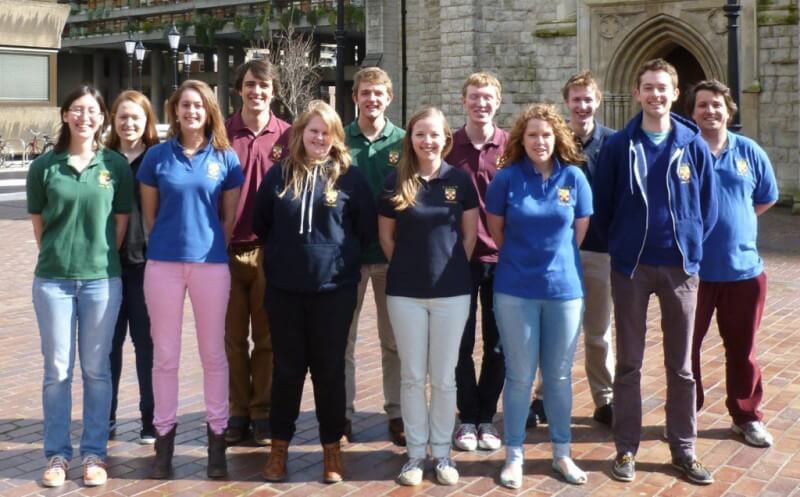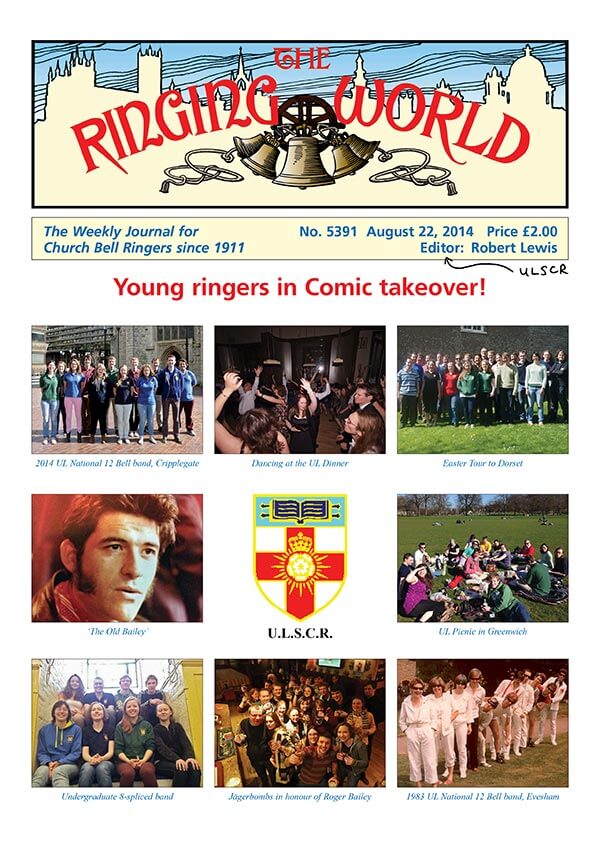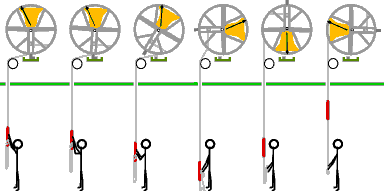 If you would like more information about learning to ring, please email: newmember.
If you would like more information about learning to ring, please email: newmember.
Alternatively, please view our Calendar & also the locations of Where & When we ring.
…see also: www.universityringing.org: Ringing Myths Exploded.
Ringing is great fun! There are about 40,000 bellringers in the UK, and 40,000 people can’t be wrong! And with that many ringers, it’s a great hobby socially too. No matter where you go in the UK, you’re never far from a tower with bells and a band of ringers who will welcome you – including the pub afterwards!
 All sorts of people are ringers. Many people seem to think that you have to be musical or perhaps mathematically-minded to ring, which isn’t true at all. We certainly don’t conform to any stereotype – most of us don’t even look all that much like Quasimodo!
All sorts of people are ringers. Many people seem to think that you have to be musical or perhaps mathematically-minded to ring, which isn’t true at all. We certainly don’t conform to any stereotype – most of us don’t even look all that much like Quasimodo!
Some people seem to think that you need to be quite strong to ring the bells, and this isn’t true either. Some bells can weigh just under a ton, which sounds a lot heavier than it feels! Not all ringers are churchgoers or religious either.
Most university ringing societies will have an active social calendar and some spend as much time drinking as they do ringing! Socials can range from: tours/outing, treasure hunts, picnics, handbells, competitions (including the Southern/Northern Universities Association weekends), peal/quarter weekends, theatre trips, concerts, parties, dinners, Ringing World infiltration (go team UL!) and lots more…
What’s Involved?
Well, the ‘CR’ in some of the society acronyms below stands for ‘Change Ringers’, which is the proper name for the type of bell-ringing we do. Basically, this means that we don’t ring tunes, but start off by rhythmically ringing a descending scale and then change the order in which the bells ring in various different ways. These “methods” are like pieces of music that we learn off-by-heart before we ring and mean there’s always something to learn, so ringing never gets dull and is always a challenge. Ringing “methods” requires concentration and a huge amount of team-work. For this reason, bell ringing is sometimes described as the ultimate team activity!

Change Ringing?
 When we ring the bells, a team of ringers (any number, but often 8) ring one bell each in turn. Each person’s bell is numbered from 1 to 8, with the lightest bell sounding the highest note numbered 1, through to the heaviest and lowest bell numbered 8. When rung in a descending scale this creates the first ‘row’: 12345678.
When we ring the bells, a team of ringers (any number, but often 8) ring one bell each in turn. Each person’s bell is numbered from 1 to 8, with the lightest bell sounding the highest note numbered 1, through to the heaviest and lowest bell numbered 8. When rung in a descending scale this creates the first ‘row’: 12345678.
In order to produce different rows, a pre-learnt mathematical pattern is rung which changes the order of the bells. This is known as ‘change ringing’, as the bells continuously change order from one row to the next. Bell Ringing is often described as “the ultimate team activity” – you simply cannot do it on your own so it fosters a great team atmosphere. Learning the patterns and ringing them in a team is where the fun really starts!
What makes Change Ringing fun?
 Ringing the ‘changes’ provides an excellent challenge for anybody to try. Once you have mastered handling the bell itself, there is the mental task of learning and ringing the patterns; this requires a lot of concentration. There is also the musical task of keeping in time within a band and striking your bell accurately and evenly spaced among the others.
Ringing the ‘changes’ provides an excellent challenge for anybody to try. Once you have mastered handling the bell itself, there is the mental task of learning and ringing the patterns; this requires a lot of concentration. There is also the musical task of keeping in time within a band and striking your bell accurately and evenly spaced among the others.
As a team we try and maintain a good sense of rhythm so that we can ring well together – this is important as we frequently ring in towers where the public can hear us! The bells can also be quite a physical challenge to ring. Tenors (the heaviest bell) can range from the weight of a motorbike to that of two large cars! This can be very hard work ringing it in time with the lighter bells. So after a good practice we all go to the pub to reward ourselves!